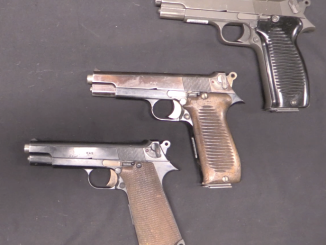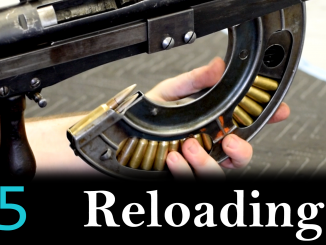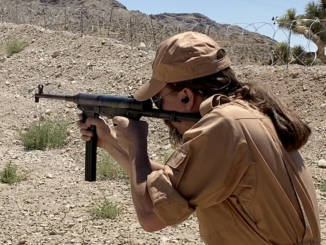The original 1890 Berthier carbine was designed for cavalry, but a slightly modified version was produced (in small numbers) with a bayonet lug, for use by the Gendarmerie. In 1892, the French military would adopt that same carbine for use by an assortment of troops who were better suited with a carbine than a full size Lebel rifle. These included primarily artillery crews, but also engineers, messengers, drivers, and others.
The Modele 1892 Mousqueton d’Artillerie was basically identical to the 1890 cavalry carbine, including the same 3-round Mannlicher type clip. It was put into production at both the St Etienne and Chatellerault factories, and by August of 1914 384,000 were in French inventory. By the time the improved 1916 model was put into production, a total of 675,000 of these carbines would be built.





Artillerymen and engineers were usually the ones who would fix bayonets to carbines because of the risk of getting overrun. Carbines are easier to carry if the primary job is lobbing explosives/shrapnel shells or digging trenches. Unlike cavalry, artillery crews and sappers can’t rapidly retreat when things get too personal. And someone needs to cover the machine gunner when he reloads. Did I mess up?
“Artillerymen (…) were usually the ones who would fix bayonets to carbines because of the risk of getting overrun.”
Depend on cannons used. Best known French cannon of that era is probably Canon de 75 modèle 1897 for which above statement might be true.
For long-range artillery this seems be less probable.
Though, it seems for me that French army, before First World War, for some reason was overlooking/ignoring heavy artillery, favoring mentioned 75 mm gun, which undoubtedly was revolutionary design, but couldn’t do everything.
The Mle 1897 was a great field gun for an open field battle with predominantly direct fire application. This kind of use was envisaged largely due to the Franco-Prussian War, where the breech-loading Krupp guns proved very effective, but the experiences of the Second Boer War also seemed to validate the continued need for such guns. As typical for the era, the Russo-Japanese War was largely ignored by the dominant Western European military thinkers.
Like most light guns of the era, the Mle 1897 was poorly suited for prolonged trench warfare, where indirect fire would be the norm. In had a great rate of fire thanks to the recoil system, fast breech and relatively light shells, but low maximum elevation, which combined with the fixed type (cartridge loading) shells limited the maximum range and ability to fire behind hills and other obstacles. In the pre-WW1 artillery doctrines that was the job for howitzers, which were available in lower numbers than guns.
Another major shortcoming related to pre-war doctrine was that field guns were provided predominantly with shrapnel shells. HE shells were reserved mainly for howitzers and mortars. Shrapnel was effective in breaking up infantry attacks, but it was practically useless for preparatory bombardment and reducing trenchworks, which soon became the major role of artillery during the war. The smallish size of the shell of course could not be helped in any case, so HE shells were not terribly effective even when they became available in larger numbers.
Adding insult to injury, the majority of Western powers thought that the Japanese merely got lucky. “If it were a proper war, Japan would be a Russian colony by now.” Let’s not imagine the results of Imperial Russia invading Japan. It would be complete carnage for both teams… Or am I wrong?
There was certain amount of denial and belittling going on for sure. On the other hand, one must remember that there was only 9 years from the end of the Russo-Japanese war to the beginning of the Great War. That is not a lot of time to analyze the events and incorporate lessons to doctrine and tactics. In comparison, the situation in Afghanistan has been more or less the same for the last 10 years and Western armies are still debating what kind of lessons could and should be learned from that conflict. If course the conflict in Afghanistan is fairly typical asymmetric warfare, so it is indeed clear that lessons from there are not directly applicable to more traditional symmetric warfare.
Also, the French military’s doctrine of the day was that the rate of fire and thus volume of fire of the 75mm would allow them to literally swamp a target with medium artillery fire, destroying any enemy rapidly and rendering heavier guns irrelevant. As Ian Hogg stated, this was the “quick-firing gun” concept gone totally mad.
A lot of it was based on their experiences on the receiving end of Prussian field artillery fire in 1870-71. The Prussians had early Krupp breechloaders, not true QFs, but the idea was there. And the few times they tried to bring their “secret weapon”, the mitrailleuse, into action, the Prussians, who had believed all the “secret weapon” hype, greeted the primitive volley guns with the heaviest artillery fire they could ring to bear. So they had already gotten the target’s-eye view of what QF fire could do, so to speak.
There was also the political and economic factor. Simply put, five 75mm were cheaper than one modern 15cm howitzer. And French generals and ministers were always entranced by the ideas of French elan’ and “L’Audace, L’Audace, Torjours L’Audace!” on the battlefield. The 75mm, rushing in to direct-fire rapid volleys over open sights, then dashing off to repeat the process elsewhere, was a better “fit” to this philosophy than heavy howitzers.
The bill got called due in 1914-16. Fist of all, 75mm wire-wound beeechloaders with complex recoil systems tended no to be as durable as even simple breechloaders, let lone muzzle-loaders. The attrition rate from simple gun wear, to say nothing of enemy action, accidents, and etc., soon put hem in the “coffin corner” on gun replacements. Hence all those photos of old-fashioned fortress-type 10cm and 15cm guns in the trenches; they were literally stripping forts in the colonies of anything that would actually shoot, and sending it to the front, complete with its elderly ammunition.
They also failed to consider the fact that their “Super QF” policy was going to require a lot of ammunition. Early on, some 75mm batteries were blasting off 1,000 rounds in even minor engagement, emptying their caissons and a couple of supply train trucks in the process. Plus, they had concentrated on shrapnel, when instantaneous-fuse and delay-fuse HE were what was really needed. The combination ended up with some 75mm units being limited to two rounds per tube per day in late 1915.
The whole wretched story (including the French military mission’s misadventures in the United States) can be found in often excruciating and sometimes almost hilarious detail in The Guns 1914-18 by Ian V. Hogg (Ballantine, 1971);
https://www.amazon.com/1914-18-Ballantines-illustrated-history-century/dp/0345024354
Not expensive, and a good read. Note that as Hogg relates, the other combatants had similar problems, and handled them almost as badly as the French did.
cheers
eon
The irony of the artillery ammunition problems was that HE shells were actually somewhat cheaper to make than shrapnel. Shrapnel shells required the shell casing to be made out of high tensile steel, because it had to be thin enough for a large number of lead-antimony (sometimes iron) balls to fit in the shell. The assembly of a shrapnel shell was also more complex and time-consuming than making HE shells.
Despite all that production could not be switched to HE shell overnight, because the pre-war production capacity of suitable high explosives and contact fuzes was not sufficient, in addition to the usual delays in re-tooling for a significantly different product in any industrial scale production. These problems were not unique to France, either; for example in 1916 British artillery was still shooting large numbers of shrapnel shells from pre and early war production, simply because there was not enough HE shells.
Actually, as Hogg points out, HE shell is a much trickier thing to make than shrapnel, especially when large quantities are called for. There aren’t too many “wrong” ways to make shrapnel, and materiel quality isn’t as critical; mild steel case + lead or even cast iron “shot” + time fuze + expulsion charge (often just black powder) = done. And a bore premature generally doesn’t do much except give the detachment a scare.
By comparison, HE shell has to pretty much be made exactly right. You can’t scrimp on the HE, as there aren’t that many types that will put up with being fired from a gun without detonating in protest right in the tube. The casing can’t be too weak, or it may not survive breech pressure. And the fuze (nose or base) had better be made right, because it’s generally an impact fuze with a secondary pyrotechnic train (or in the case of AA, a clockwork time fuze), and it has to be good enough to go off at the right time but not so sensitive it also reacts badly to a 200+ gravity kick in the pants when the lanyard is pulled.
To make up their shortage of HE shell, the French first tried making shell bodies from pressed steel or cast iron that could withstand only about 60% of the pressure that the standard prewar high-tensile steel bodies could. They also tried substitute explosives to cope with shortages of their usual shell filling, Melinite (picric acid). The combination of less suitable HE with weaker shell bodies resulted in not just duds but BPs that wrecked guns and scared the living bejabers out of their crews. They broke the impasse by redesigning HE shells with first wrought iron and then cast steel bodies and less HE capacity. This reduced the BPs but also meant that they had to fire more HE onto a target to get the same effect.
With heavier guns, they redesigned the HE shells right from the start. A 75mm bore premature was bad enough, and added to the number of guns that had to replaced, but a 15cm or 24cm BP would require the replacement of the gun, its detachment, and probably anything else within a 50 meter radius, like the rest of the battery. (Triple that if he initial blast radius included the shells stowage.)
Even after the U.S. became the arsenal of the Allies, and right up to the Armistice, there really was never enough HE shell for field guns to go around, with the heavy guns getting top priority for that type. It was a situation that different armies learned different lessons from.
The U.S. Army started from scratch to come up with an optimized set of field and divisional guns, settling on three bore sizes; 105mm, 155mm, and 203mm. After the Westervelt Board in 1918 and the French Board in the 1930s, they finally got them into production and service- in 1941.
The British Army decided to first come up with a heavier gun that could fit their existing carriages, and then a brand-new gun that was supposed to do everything except AA and anti-tank shooting. The result was the various flavors of the 25-pounder that showed up in 1940.
The Germans decided to get out of the whole tangled mess by concentrating on armor and mobility, backed up by tactical airpower. The result was called “Blitzkrieg”.
The French…built the Maginot Line. With enough heavy, emplaced guns and ammunition stores to shoot up anything. And which did not cover the Belgian border for “diplomatic” reasons.
Well, we all know how all that turned out.
cheers
eon
“HE, as there aren’t that many types that will put up with being fired from a gun without detonating in protest right in the tube.”
That is why such weapons as pneumatic guns, were created, most known is probably Zalinski dynamite gun, but there were others as well:
http://www.douglas-self.com/MUSEUM/COMMS/pneuguns/pneuguns.htm
this concept was revived during WW1 for usage in high-angle guns.
Great Britain has also similar problem (not enough ammunition), it is known as Shell Crisis of 1915:
https://en.wikipedia.org/wiki/Shell_Crisis_of_1915
“The Germans decided to get out of the whole tangled mess by concentrating on armor and mobility, backed up by tactical airpower. The result was called “Blitzkrieg”.”
Though they have also self-propelled artillery, like Leichte Feldhaubitze 18/2 auf Fahrgestell Panzerkampfwagen II (Sf.) (also known as Wespe), 15 cm sIG 33 (Sf) auf Panzerkampfwagen I Ausf B (also known as Bison) or Panzerfeldhaubitze 18M auf Geschützwagen III/IV (Sf) Hummel
The Germans, somewhat like the US, also standardized their field artillery to a 105mm and 150mm pieces during Nazi rearmament. 75mm field guns were made in relatively small numbers initially, but soon production was concentrated on heavier pieces. They did produce a large quantity of 75mm infantry guns, but like the name suggests, they were not field artillery pieces but heavy support weapons for the infantry and normally used in direct fire mode (although the crews were trained for indirect fire and it was sometimes used as well in lieu of mortars).
The Germans did have heavier than 150mm artillery pieces, but in much smaller numbers. They were typically corps or army artillery and intended for “special” tasks such as counter-battery and other long range fire. In Russia they also used large numbers of captured Soviet 122mm and 152mm pieces, out of necessity and shortage of domestic artillery pieces. From late 1942 onwards a huge portion of German artillery production was switched to heavy AA guns (88mm, 105mm and finally 128mm), which meant a chronic and bad shortage of field artillery pieces.
EW;
They also of course had such one-off monsters as the “Karl-gerat” 55cm and 60 cm rail-deployed SP howitzers and the huge “Schwere Gustav” 80cm double-track railway gun.
Those were developed because of the one lack in the Luftwaffe’s inventory, an effective heavy bomber. The He-177 was really more of a long-range medium better suited to maritime ops- see Martin P4M Mercator, which paralleled the He-177 in several design features;
https://en.wikipedia.org/wiki/Martin_P4M_Mercator
The Wehrmacht ended up with the Brobdingnagian guns with actually rather short ranges (40-45km for the 80cm, under 7km for the 60cm and 55cm) because that was all they had that could deliver heavy HE charges onto serious “points of resistance”. Unlike American or British commanders, who could just call up however many Forts, Libs, Lancs or Halibags needed to erase the stubborn thing from the map with thousand-pounders.
I’ve often thought that the A4 rocket would have made more sense for the Wehrmacht as a long-range divisional support weapon than as a terror weapon. Assuming accuracy within 5000m at 250 km could be achieved, or better yet 500m at 30-40km, a couple of A4 batteries attached to each Army Group would have been a much more cost-effective way of reducing hard targets than an 80cm gun the size of Coventry Cathedral.
cheers
eon
D;
There were also compressed-air and acetylene mortars used in WW1, notably by the Austrians. Although there, the main motivation wasn’t “soft-launch” of bombs with sensitive fillings as much as it was just trying to economize on the use of propellant powders that were badly needed for heavier artillery.
cheers
eon
Eon;
The Germans also literally raided a museum in Austria after the Anschluss for a 305mm M11 Skoda mortar, which they intended to use against the Maginot line. Unfortunately for them, most of the Austro-Hungarian heavy siege artillery pieces (not only 305mm but also the even heavier 380mm and 420mm ones) had been given to Italy as war reparations after WW1, but the Italians did not use them at all in WW2. By the time the Germans finally got their hands on them in September 1943, they were no longer needed.
“The Germans also literally raided a museum in Austria after the Anschluss for a 305mm M11 Skoda mortar, which they intended to use against the Maginot line. Unfortunately for them, most of the Austro-Hungarian heavy siege artillery pieces (not only 305mm but also the even heavier 380mm and 420mm ones) had been given to Italy as war reparations after WW1, but the Italians did not use them at all in WW2. By the time the Germans finally got their hands on them in September 1943, they were no longer needed.”
According to: https://de.wikipedia.org/wiki/30,5-cm-M.11-Mörser#Weitere_Verwendung_nach_dem_Ersten_Weltkrieg
Germans have captured unknown number of 30,5-cm mortars from Czechoslovakia, named it 30,5-cm-Mörser(t), no less than one M 16 was actually used for firing at Maginot Line. Later, in April 1941, Germans captured unknown number from SHS Kingdom (see: Unternehmen Marita) and named it 30,5-cm-Mörser 638(j). Total number of captured was equal to 6. These mortars were later used during Siege of Sevastopol and Siege of Leningrad.
“Those were developed because of the one lack in the Luftwaffe’s inventory, an effective heavy bomber.”
As the German doctrine call for fast campaigns (after all it is named Blitzkrieg for reason) it is not surprise, than they prefer lighters aeroplanes, more suitable for close support of own advancing troops and attacking “shallow” rear of enemy.
“He-177″
Independently from its role, this never works reliable. Problems with engines were never totally solved – despite He 177 looks like twin engine aeroplane, it is in fact four-engined – each nacelle hold in fact 2 engines. This allows smaller air resistance than four nacelles, but also mean bigger problem with cooling of rear engines. Additionally some problems with engine installation lead to He 177 getting nicknames like „Brennender Sarg“ (Flaming Coffin), „Reichsfackel“ (Reich torch), „Reichsfeuerzeug“ (Reich lighter)
” “Karl-gerat”(…) “Schwere Gustav””
That second might be called abomination and probably would rank high in III Reich’s weapons for least cost-effective artillery weapons.
Karl-Gerät on the other hand was reasonable mobile for mass of projectile it launched. Though traveling at moderate 10 kph at best, when self-propelling, it don’t need building of firing position as some earlier heavy artillery pieces. Also there were other railroad guns, beyond Schwerer Gustav, which were much more well-suited for usage, like 28 cm Kanone 5 (Eisenbahn) known also as Krupp K5, which used single railway.
Daweo;
You are of course right that some ex-Austro-Hungarian heavy siege artillery pieces were captured from Czechoslovakia and later used as well. Still, the Italians had more of them than Czechoslovakia and Austria combined.
“Hence all those photos of old-fashioned fortress-type 10cm and 15cm guns in the trenches;”
Including Mortier de 15 cm Mle 1838 ‘Crapouillot’
http://www.passioncompassion1418.com/Canons/Eng_AfficheCanonGET.php?IdCanonAffiche=420
It’s always seemed odd to me that the French used a different bayonet fitting on the carbines than on the Lebel. I can see changing from a cruciform to a spike, but why change the fitting? Otherwise, you’d only need one nose cap in inventory.
Looking for some input here. I have one of these with some considerable trench art, as well as what appears to be a customized cleaning kit “space” built into the buttstock, complete with intact tools and oil container. (Looks like a double-ended cigar holder) Have you seen or heard of anything like this mod? Pics if you like and thanks for your rear work!
*great haha!